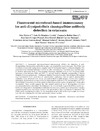Please use this identifier to cite or link to this item:
https://accedacris.ulpgc.es/handle/10553/42542
| Title: | Fluorescent microbead-based immunoassay for anti-Erysipelothrix rhusiopathiae antibody detection in cetaceans | Authors: | Melero, Mar Giménez-Lirola, Luis G. Rubio-Guerri, Consuelo Crespo-Picazo, José Luis Sierra Pulpillo, Eva María García-Párraga, Daniel García-Peña, Francisco Javier Arbelo, Manuel Álvaro, Teresa Valls, Mónica Sánchez-Vizcaíno, José Manuel |
UNESCO Clasification: | 240119 Zoología marina 310903 Inmunología |
Keywords: | Antibodies Cetaceans Erysipelas Erysipelothrix rhusiopathiae Fluorescent microbeadbased immunoassay |
Issue Date: | 2016 | Journal: | Diseases of Aquatic Organisms | Abstract: | A fluorescent microbead-based immunoassay (FMIA) for detection of anti-Erysipelothrix rhusiopathiae antibodies in pigs was adapted for use in cetaceans. The FMIA was validated and adjusted using serum samples from 10 vaccinated captive bottlenose dolphins Tursiops truncatus collected between 1 and 13 mo after immunization. The technique was then used to analyze specimens from 15 free-ranging cetaceans stranded alive on the Valencian Medi-terranean coast between 2006 and 2014: 11 striped dolphins Stenella coeruleoalba, 3 Risso's dolphins Grampus griseus and 1 bottlenose dolphin Tursiops truncatus. One of these wild animals was confirmed to have died from E. rhusiopathiae septicemia, but no anti-E. rhusiopathiae antibodies were detected in its serum, pericardial fluid or milk samples. Another free-ranging individual, which lacked any signs or lesions that might be indicative of E. rhusiopathiae infection, showed high fluorescence intensity similar to that measured in captive dolphins at 6-13 mo after vaccination. These results suggest that this animal underwent an E. rhusiopathiae infection several months before stranding. The findings in the present study suggest that FMIA can be useful for detecting anti-E. rhusiopathiae antibodies in cetaceans, and its application to free-ranging animals is particularly interesting because of the great value of these specimens. Furthermore, the FMIA can be multiplexed to allow the determination of up to 100 analytes per sample in a single well, thereby reducing the cost, time and sample volume needed. | URI: | https://accedacris.ulpgc.es/handle/10553/42542 | ISSN: | 0177-5103 | DOI: | 10.3354/dao02948 | Source: | Diseases of Aquatic Organisms [ISSN 0177-5103], v. 117 (3), p. 237-243 |
| Appears in Collections: | Artículos |
SCOPUSTM
Citations
4
checked on Jun 8, 2025
WEB OF SCIENCETM
Citations
3
checked on Jun 8, 2025
Page view(s)
55
checked on Sep 16, 2023
Download(s)
80
checked on Sep 16, 2023
Google ScholarTM
Check
Altmetric
Share
Export metadata
Items in accedaCRIS are protected by copyright, with all rights reserved, unless otherwise indicated.
